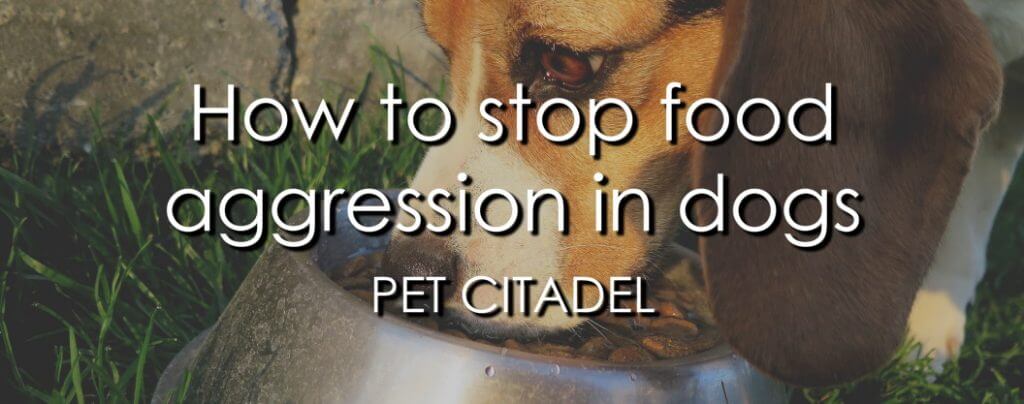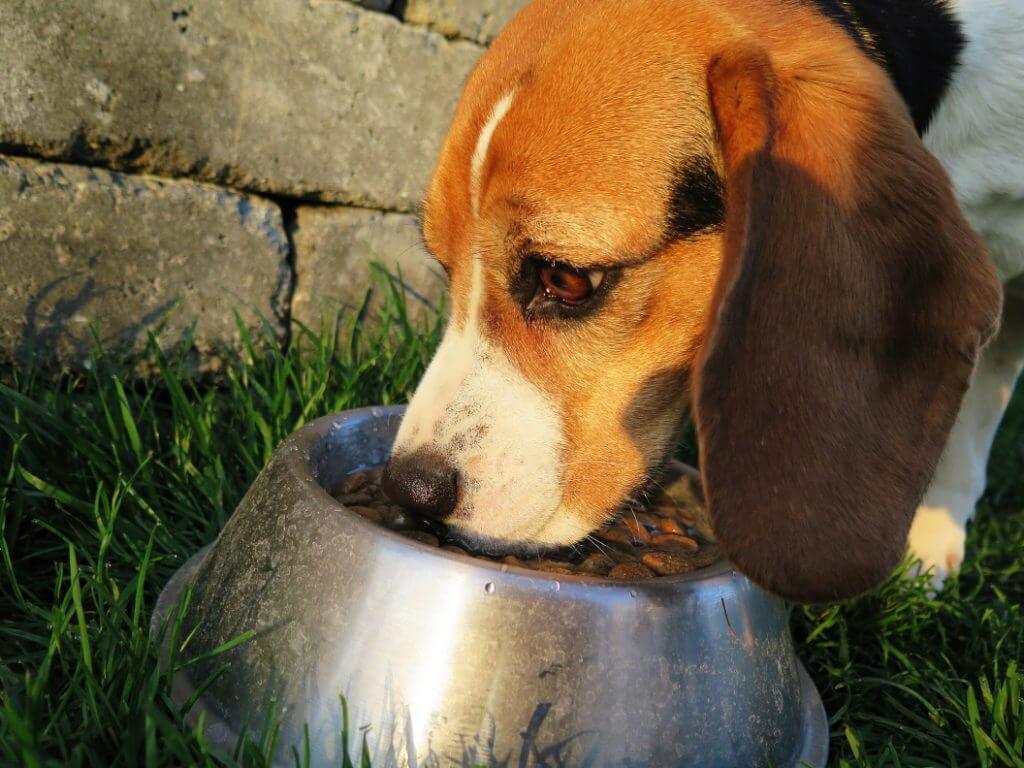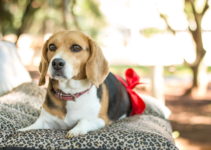This post may contain affiliate links. You can view our affiliate disclosure here.

Food aggression is not an abnormal behavior in dogs; it’s a natural survival instinct.
However, it’s not the sort of behavior we want to encourage in our dogs — it can result in biting, violence, and injuries. This is why some action will need to be taken.
Your dog will probably develop food aggression over time rather than it appearing suddenly. It is more than likely to be brought on by aspects of its environment which have brought the instinct to the fore.
In your dog’s mind, protecting its food is normal behavior, and it might have a hard time understanding why you want to stop it.
Looking At Wild Dogs
As with many aspects of dog behavior, it’s useful to look at the behaviour exhibited by wild dogs.
In a wild situation, dogs are forced to be protective over their share of the food; otherwise, other members of the pack will take it and the dog will starve.
This is a natural reaction to a scarcity of resources. When a pack has only just enough food to live on, then it’s survival of the fittest.
The strongest dogs will thrive by forcibly taking the food of the weaker dogs. It is part of natural selection and is an inherited instinct. This behavior is rooted deep inside your dog.
The Broader Aspects of Guarding

With wild dogs, it is not only necessary to guard shares of food, but also to guard the mate, the sleeping area, and any resources the dog may feel it owns. These things are seen as important to its security.
In the home, you may notice that your dog runs away with its toys when you approach them. Or it may steal an item or piece of garbage that smells interesting and then guard it against you.
To the dog, these toys and trash items are valuable resources and they are under its ownership!
Your dog can express its possessiveness of these items in different ways. It may growl whenever a stranger comes near the valuables, simply warning them off from stealing its item.
Food guarding is the most common problem, and we will look at how to stop it next.
Tackling Food Aggression

The most important job to tackle is convincing the dog that:
- Nobody is trying to take the food away from it.
- There is plenty of food, so there is no threat to it.
Clearly, since we humans are unlikely to be eating dog food, the dog likely feels that there is another animal that is a threat to its food, especially if it experienced food competition in the past.
It could have been when the dog was a puppy and the pack scrambled to eat from a common bowl. I might be that you have other dogs (or even cats) that it perceives as a threat to its food security.
Either of these things could have brought food aggression to the surface.
Your task is training the dog to understand that it will have plenty of food no matter what, and that those other animals in your household are not a threat.
The Process
One of the best techniques is laid out in these four phases. Only progress when you have completed each phase.
Phase 1
- Stand near your dog while it is eating. Do NOT move towards it.
- Say something like “that’s a good dinner” and at the same time throw it a treat.
- Repeat the previous steps every few seconds until your dog has finished dinner.
- Repeat this until your dog is able to eat 10 meals without showing aggression.
- Move on to Phase 2.
Phase 2
- Follow the same steps as in Phase 1, but take a step towards the dog, and then step back.
- Each day, move a little closer.
- Once your dog stays relaxed for 10 meals, move on to Phase 3.
Phase 3
- While your dog is eating, walk slowly up to the bowl, drop a treat into the bowl, and then just walk away. Talk gently while you do this.
- Repeat this every 30 seconds until the dog has finished its meal.
- When your dog is relaxed for 10 meals, move on to Phase 4.
Phase 4
- While your dog is eating, walk up to it (speaking gently).
- Bend down, give it a treat, and then walk away.
- Repeat every thirty seconds until the dog has finished eating.
- When your dog is relaxed for 10 meals, move on to Phase 5.
Phase 5
- While your dog is eating, walk up to it (speaking gently).
- Bend down and give it a treat with one hand while touching its bowl with the other, and then walk away.
- Repeat this every 30 seconds until the dog has finished its meal.
- When your dog is relaxed for 10 meals, move on to Phase 6.
Phase 6
- While your dog is eating, walk up to it.
- Bend down and give it a treat with one hand while lifting its bowl a few inches with the other hand, and then walk away.
- Repeat this every 30 seconds until the dog has finished its meal.
- When your dog is relaxed for 10 meals, move on to Phase 7.
Phase 7
Repeat phases 1-6 with all members of the family taking the action, so that the dog knows the same rules apply to everyone.
A Similar Behaviour

There’s one last behavioural issue that’s worth mentioning; it’s actually the same issue we’ve been talking about, but in a different form.
Sometimes, if you lay out food on a coffee table for guests, your dog might snap at the guests when they try to take the food.
This is your dog exhibiting the same instinctive behavior, but this time protecting the family food from outsiders. You can use treats and conditioning to address this.
Conclusion
As you can see, stopping food aggression in your dog is going to take time and work by you and members of your family.
However, it should be a one time fix, and will make the living situation in your home much better.
If you suspect a health problem might be responsible for the food aggression, you should go see a veterinarian immediately.
If you’ve ruled out a health problem, it’s possible that you won’t be able to fix the issue yourself. If this is the case, or if you don’t have time to fix it, there is a very economic solution available.
A certified dog trainer with well over a decade of experience working with clients has created an online program and community for dog owners.
This trainer has figured out that aggression issues like food aggression or aggression towards other dogs fundamentally come down to learning how to calm your dog down so it can regain control of its emotions.
This dog rehabilitation package is substantial, and it costs a tiny fraction of what you would pay for the services of a typical dog trainer or behaviorist.
You can alternatively read my review of the program.
Thanks for reading. Does your dog have food aggression? Feel free to share your experiences in the comments below.



